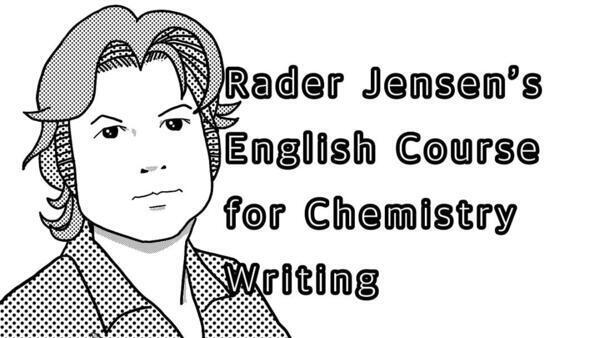[化学論文のための英語講座] 第79回:序論の復習 Introduction Review
2025年5月19日

(English version is here.)
動詞の時制の使い分けは一つの文節だけでなく、周囲の文脈にも繋がることを、前回の要旨を使った復習で学びました。以下の序論で、全体の流れがなめらかになるように適切な動詞を括弧内から選択してください。要旨の復習と同じように、選択肢のほとんどは文法的に正しいものです。序論における最も自然な動詞の時制は、要旨における時制とは異なることに注意してください。
Recent advances in homogeneous metal catalysis (1 are/were/have been) fairly dependent on the development of supporting ligands, due to the strong influence of ligand properties on the catalytic performance of transition metal complexes. Although phosphanes, imines, and pyridine derivatives (2 are/were/have been) most widely used, novel ligands with unique electronic properties (3 are/were/have been) appearing. For example, N-heterocyclic carbenes (NHC) (4 are/were/have been) powerful σ-donors, which (5 enable, enabled, have enabled) versatile transformations in palladium-catalysed reactions. NHC ligands (6 lead, led, have led) to significant improvements in olefin metathesis as well. More recently, phosphaalkenes with a P=C double bond (7 are/were/have been) investigated as supporting ligands. We (8 report/reported/have reported) highly efficient catalyses using 1,2-diaryl-3,4-diphosphinidenecyclobutenes as bidentate ligands. Illustrative examples (9 include, included, have included) dehydrative allylation with allylic alcohols, hydroamination of 1,3-dienes with aniline, conjugate addition of benzyl carbamate to α,β-unsaturated ketones, and Z-selective hydrosilylation of alkynes. This paper (10 reports/reported/has reported) the synthesis and coordination chemistry of 1-phosphaethenyl-2-phosphanylferrocenes with planar chirality. These (11 are/were/have been) prepared for direct comparison of the ligand properties of phosphaalkene and phosphane as well as for application in catalytic asymmetric reactions.
和訳:
均一系金属触媒の最近の進歩は、遷移金属錯体の触媒性能に配位子の特性が強く影響するため、支持配位子の開発にかなり依存している。ホスファン、イミン、ピリジン誘導体が最も広く使用されているが、ユニークな電子特性を持つ新しい配位子も登場している。例えば、N-複素環カルベン(NHC)は、強力なσ供与体であり、パラジウム触媒反応で多様な変換を可能にする。NHC配位子はオレフィンメタセシスにおいても著しい改善をもたらした。さらに最近では、P=C二重結合を持つホスファアルケンが支持配位子として研究されている。我々は1,2-ジアリール-3,4-ジホスフィニデンシクロブテンを二座配位子として使用する高効率触媒を報告した。具体例としてはアリルアルコールによる脱水アリル化、アニリンによる 1,3-ジエンのヒドロアミノ化、α,β-不飽和ケトンへのベンジルカルバメートの共役付加、およびアルキンの Z 選択的ヒドロシリル化が挙げられる。この論文では、面性キラリティーを持つ 1-ホスファエテニル-2-ホスファニルフェロセンの合成と配位子化学について報告する。この化合物を合成することによって、ホスファアルケンとホスファンの配位子特性を直接比較し、不斉触媒反応にも応用できる。
解説:
この序論は一つの時間軸から語っていますが、過去から現在まで続く出来事に言及しています。現在形、過去形、現在完了形を試してみましょう。
ア. 現在形の場合:1. are, 2. are, 3. are, 4. are, 5. enable, 6. lead, 7. are, 8. report, 9. include, 10. reports and 11. are
これは文法的には正しく、特に奇妙であるわけではありませんが、継続性があり、何も変化していないという印象を与えます。それは何か新しいものの紹介というよりは、事実を述べているように思えます。
イ. 過去形の場合:1. were, 2. were, 3. were, 4. were, 5. enabled, 6. led, 7. were, 8. reported, 9. included, 10. reported and 11. were
これも文法的に正しいのですが、これら全ての記述は過去には正しかったが、現在はもはや正しくないかも知れないという印象を与えます。
ウ. 現在完了形の場合:1. have been, 2. have been, 3. have been, 4. have been, 5. have enabled, 6. have led, 7. have been, 8. have reported, 9. have included, 10. have reported, and 11. have been
これは文法的に正しく、過去に始まって現在まで続いている状況や行動という印象を与えますが、いくつかの選択は少し間違っているようです。具体的に、4, 9, 10, 11 は少し違和感があります。
上の誤った4つをより適切に表現する時制を選択しましょう:1. have been, 2. have been, 3. have been, 4. are, 5. have enabled, 6. have led, 7. have been, 8. have been, 9. include, 10. reports, 11. were N-複素環カルベンは、過去も現在も、そしてこれからも強力なσ供与性配位子であるため、4を現在形に変更します。これらの例は、過去も現在も、そしてこれからも例であり続けるため、9を現在形に変更します。同様に、この論文が現在読まれているため、10を現在形にします。そうして最後に、11は過去形です。これは、論文で報告されているフェロセンは、過去のある時点で合成されているためです。
要約と比較すると、序論では動詞の時制がより多様です。現在完了形が目立ちますが、現在形や過去形も見られます。
次回もどうぞお楽しみに。
We learned in our previous review exercise with a hypothetical abstract that verb tense use is dependent not only on a single phrase, but also on the surrounding context. In the following hypothetical introduction, select verbs from within the parenthesis that provide a smooth flow through the entire paragraph. As with the abstract exercise, most of the possibilities are grammatically correct. Note that the most natural verb tenses in the introduction are different from those in the abstract.
Recent advances in homogeneous metal catalysis (1 are/were/have been) fairly dependent on the development of supporting ligands, due to the strong influence of ligand properties on the catalytic performance of transition metal complexes. Although phosphanes, imines, and pyridine derivatives (2 are/were/have been) most widely used, novel ligands with unique electronic properties (3 are/were/have been) appearing. For example, N-heterocyclic carbenes (NHC) (4 are/were/have been) powerful σ-donors, which (5 enable, enabled, have enabled) versatile transformations in palladium-catalysed reactions. NHC ligands (6 lead, led, have led) to significant improvements in olefin metathesis as well. More recently, phosphaalkenes with a P=C double bond (7 are/were/have been) investigated as supporting ligands. We (8 report/reported/have reported) highly efficient catalyses using 1,2-diaryl-3,4-diphosphinidenecyclobutenes as bidentate ligands. Illustrative examples (9 include, included, have included) dehydrative allylation with allylic alcohols, hydroamination of 1,3-dienes with aniline, conjugate addition of benzyl carbamate to α,β-unsaturated ketones, and Z-selective hydrosilylation of alkynes. This paper (10 reports/reported/has reported) the synthesis and coordination chemistry of 1-phosphaethenyl-2-phosphanylferrocenes with planar chirality. These (11 are/were/have been) prepared for direct comparison of the ligand properties of phosphaalkene and phosphane as well as for application in catalytic asymmetric reactions.
Explanation:
This hypothetical introduction speaks from a single time frame, but it references events from the past and conditions that continue to the present. Let us try the present, preterit, and present perfect.
A. all present: 1. are, 2. are, 3. are, 4. are, 5. enable, 6. lead, 7. are, 8. report, 9. include, 10. reports and 11. are
This is grammatically correct and does not stand out as being particularly strange, but it gives the impression of continuity, the impression that nothing is changing. It comes across as a statement of fact rather than an introduction to something new.
B. all preterit: 1. were, 2. were, 3. were, 4. were, 5. enabled, 6. led, 7. were, 8. reported, 9. included, 10. reported and 11. were
This is also grammatically correct but it gives the impression that all of these statements were correct in the past, but are perhaps no longer true.
C. all present perfect: 1. have been, 2. have been, 3. have been, 4. have been, 5. have enabled, 6. have led, 7. have been, 8. have reported, 9. have included, 10. have reported, and 11. have been
This is grammatically correct and gives the impression of conditions and actions that began in the past and continue to the present, but a few entries seem a bit off. More specifically, 4, 9, 10 and 11 seem a bit off.
Select a tense that better expresses these four: 1. have been, 2. have been, 3. have been, 4. are, 5. have enabled, 6. have led, 7. have been, 8. have been, 9. include, 10. reports, 11. were. We change 4 to present because N-heterocyclic carbenes were, are, and continue to be strong σ-donor ligands. We change 9 to present because the examples were, are, and continue to be examples. Likewise, 10 is present because this paper is being read at this moment. And finally, 11 is preterit because the ferrocenes reported in the paper were prepared at a single time frame in the past.
Compared to an abstract, verb tenses in an introduction are more varied. Although the present perfect is prominent, the simple present and preterit also appear.
We look forward to see in you next time.